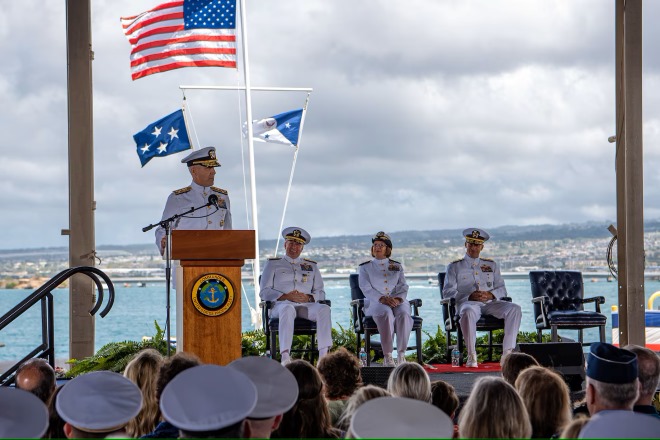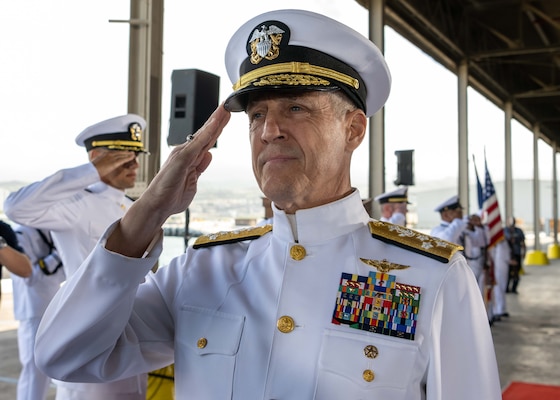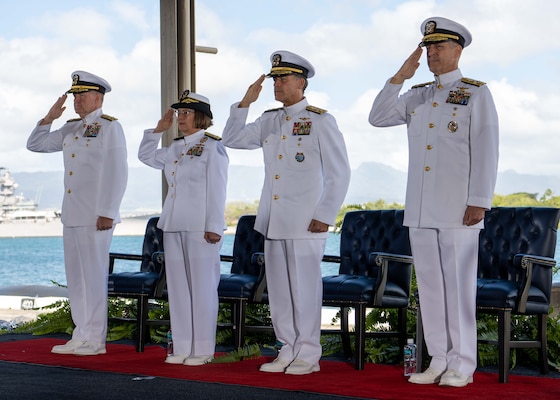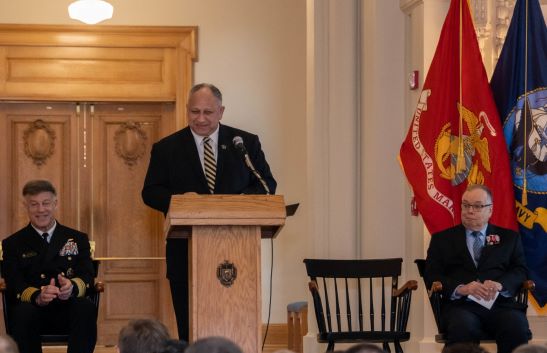PEARL HARBOR, Hawaii – Adm. Stephen Koehler assumed command of the U.S. Pacific Fleet (PACFLT) during a change of command ceremony on Joint Base Pearl Harbor-Hickam on April 4. He relieved Adm. Samuel Paparo, who took over as commander of PACFLT in May 2021.
[Photo above: Adm. Stephen Koehler addresses the audience after becoming the commander, U.S. Pacific Fleet during the COMPACFLT change of command ceremony onboard Joint Base Pearl Harbor-Hickam, April 4. (U.S. Navy photo by Mass Communication Specialist 2nd Class Jeremy R. Boan)]
Adm. John Aquilino, commander, U.S. Indo-Pacific Command, opened the ceremony by thanking Adm. Lisa Franchetti, chief of naval operations, for sending her best leaders to U.S. Pacific Fleet.
“You are looking at the world’s greatest warfighters sitting behind me,” said Aquilino. “In the world’s most concerning theater, against our world’s most dangerous adversaries, what has been chosen to run this theater are our best warfighters. That is not by accident.”
Adm. Lisa Franchetti, chief of naval operations, presided over the ceremony. She welcomed Koehler and praised Paparo for his leadership during his time as the PACFLT commander.
“Sam, you understood that the most powerful tool we have — our true strategic advantage — comes from our strong relationships with our allies and partners,” said Franchetti. “And that our shared values and common interest bind us together, and put more ready players on the field — every single day. Sam, I cannot be more proud of the work that you’ve done as the Pacific Fleet commander, and I’m excited about what is yet to come as you head up the hill (to Camp Smith), and become the 27th commander of U.S. Indo-Pacific Command next month.”
Franchetti welcomed Koehler saying: “You know how to build strong teams to get after our vital mission here in the Indo-Pacific at this critical time in our nation’s history. There is no one more ready to lead this Fleet. I am absolutely confident that you are the right person at the right time to lead our Sailors in the Indo-Pacific. And I look forward to seeing all that this Fleet will accomplish on your watch.”
While under Paparo’s command, PACFLT qualified as a joint task force, established Task Force 504, a task force focused on combat sustainment; Fleet Information Warfare Command Pacific; expanded opportunities for deployed ship repair in India; and completed numerous joint and combined multi-lateral operations across the region with allies and partners.
“These accomplishments and many more have demonstrated our capability and our will to our would-be adversaries. These accomplishments have deterred conflict and preserved the peace,” said Paparo.
He took a moment to address the Sailors, chief petty officers, civilians and officers across the Fleet, both at sea and ashore.
“The best part of my job has been watching this team in action,” Paparo said. “I appreciate all that you have done over the last three years. And as I utter these words, your efforts continue. Every day you continue building a more effective fighting force. I am honored to remain your teammate as I take up my next duty, and I am proud to turn over command to Adm. Stephen “Web” Koehler.”
Koehler comes to the historic Pearl Harbor headquarters from Washington, D.C., where he served as director for Strategy, Plans and Policy, J5, Joint Staff.
“I could not be more excited and honored to assume command of the finest fleet in the world, whose capabilities are second to none,” said Koehler. “The U.S. Pacific Fleet answers our nation’s call to compete with unity of purpose, without hesitation, and with a powerful and resolute force.”
Koehler is the 38th commander since the Fleet’s Pearl Harbor headquarters was established in February 1941. He commissioned through the Naval Reserve Officers Training Corps (NROTC) at University of Colorado at Boulder in 1986, and was designated a naval aviator in March 1989. He has flown over 3,900 hours in the F-14 Tomcat and F-18 E/F/G Super Hornet with 600 carrier landings.
U.S. Pacific Fleet is the world’s largest fleet command with an area of operations that encompasses 100 million square miles, nearly half the Earth’s surface, from Antarctica to the Arctic Circle and from the West Coast of the United States into the Indian Ocean. The U.S. Pacific Fleet consists of approximately 200 ships and submarines, nearly 1,200 aircraft, and more than 130,000 Sailors and civilians.





